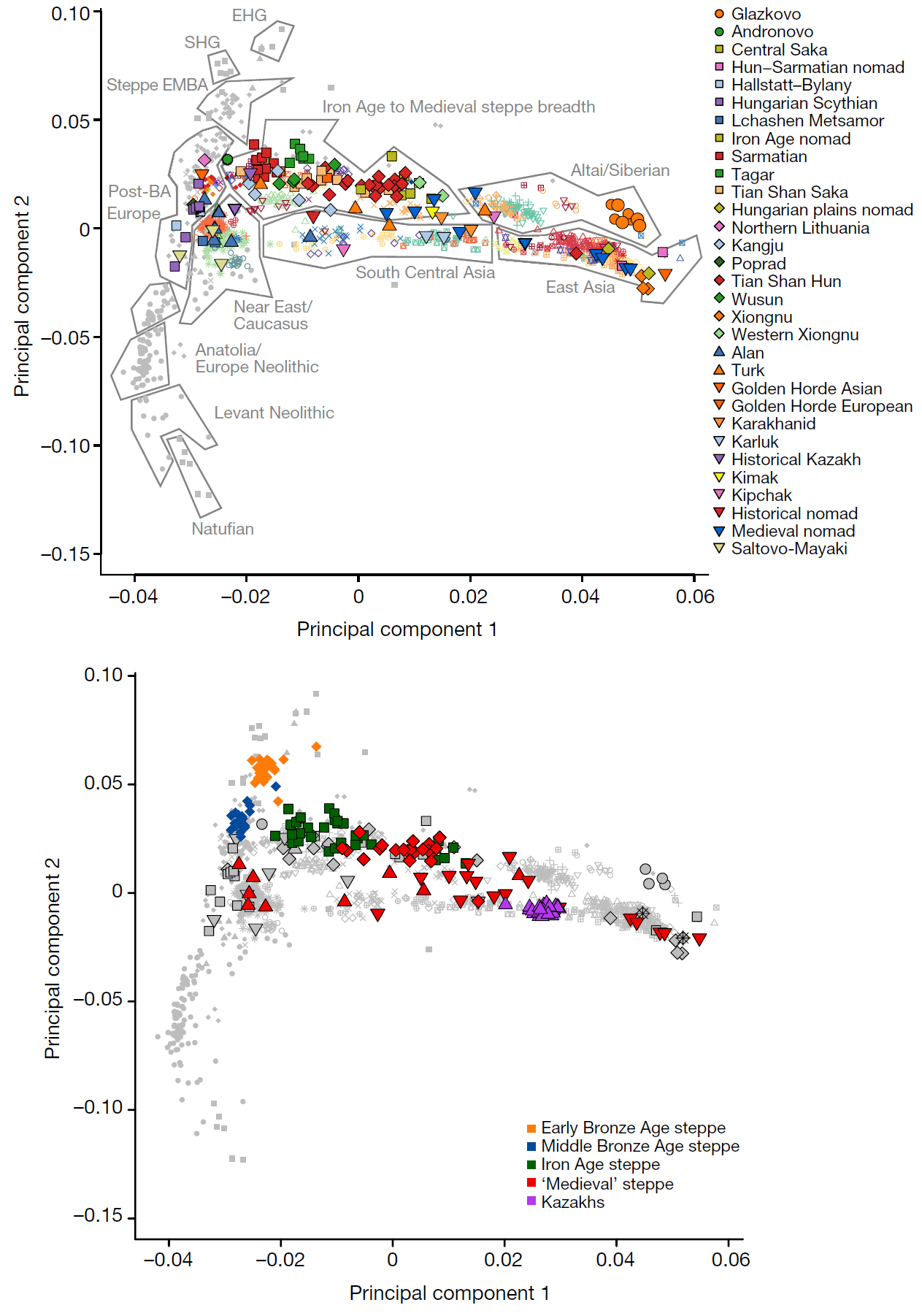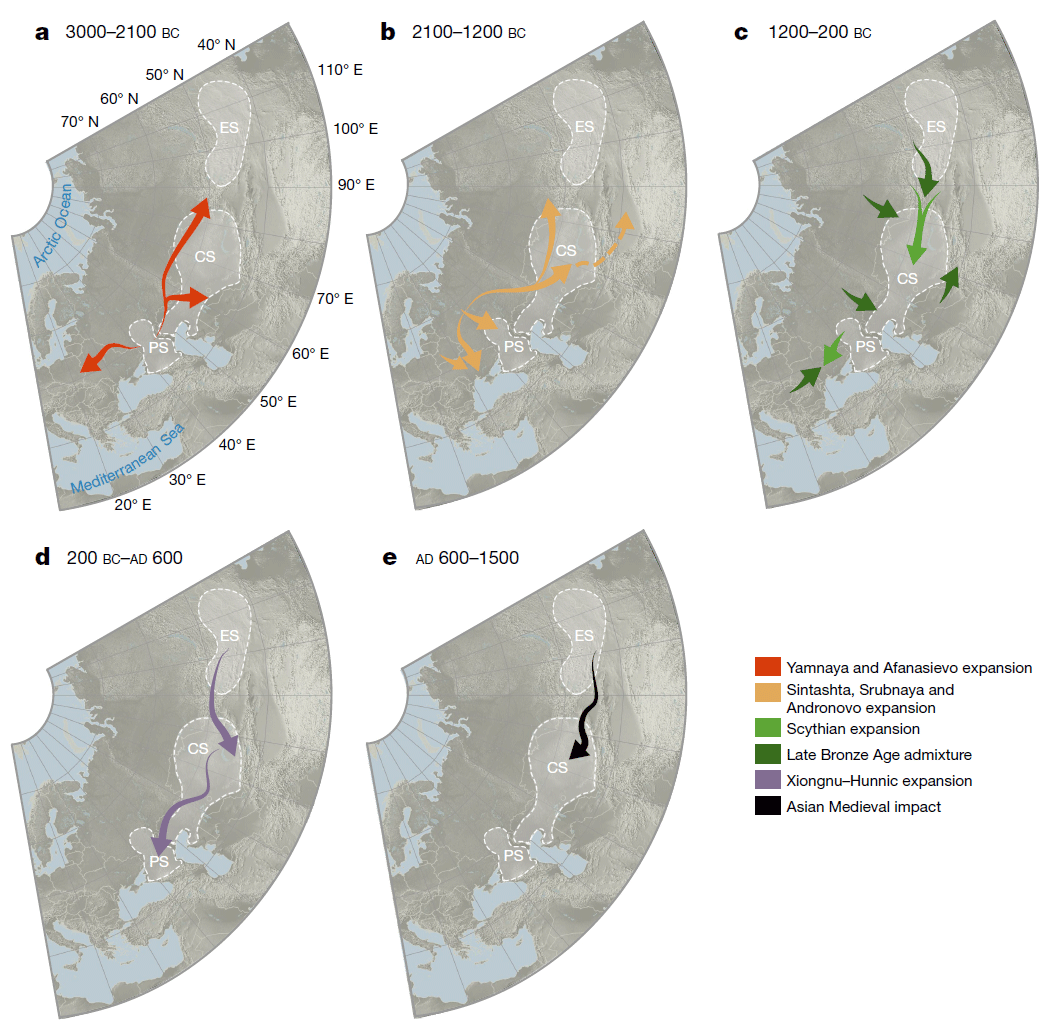The expected study of Eurasian samples is out (behind paywall): 137 ancient human genomes from across the Eurasian steppes, by de Barros Damgaard et al. Nature (2018).
Dicussion (emphasis mine):
Our findings fit well with current insights from the historical linguistics of this region (Supplementary Information section 2). The steppes were probably largely Iranian-speaking in the first and second millennia bc. This is supported by the split of the Indo-Iranian linguistic branch into Iranian and Indian33, the distribution of the Iranian languages, and the preservation of Old Iranian loanwords in Tocharian34. The wide distribution of the Turkic languages from Northwest China, Mongolia and Siberia in the east to Turkey and Bulgaria in the west implies large-scale migrations out of the homeland in Mongolia since about 2,000 years ago35. The diversification within the Turkic languages suggests that several waves of migration occurred36 and, on the basis of the effect of local languages, gradual assimilation to local populations had previously been assumed37. The East Asian migration starting with the Xiongnu accords well with the hypothesis that early Turkic was the major language of Xiongnu groups38. Further migrations of East Asians westwards find a good linguistic correlate in the influence of Mongolian on Turkic and Iranian in the last millennium39. As such, the genomic history of the Eurasian steppes is the story of a gradual transition from Bronze Age pastoralists of West Eurasian ancestry towards mounted warriors of increased East Asian ancestry—a process that continued well into historical times.
This paper will need a careful reading – better in combination with Narasimhan et al. (2018), when their tables are corrected – , to assess the actual ‘Iranian’ nature of the peoples studied. Their wide and long-term dominion over the steppe could also potentially explain some early samples from Hajji Firuz with steppe ancestry.
fku

For the moment, at first sight, it seems that, in terms of Y-DNA lineages:
- R1b-Z93 (especially Z2124 subclades) dominate the steppes in the studied periods.
- R1b-P312 is found in Hallstatt ca. 810 BC, which is compatible with its role in the Celtic expansion.
- R1b-U106 is found in a West Germanic chieftain in Poprad (Slovakia) ca. 400 AD, during the Migration Period, hence supporting once again the expansion of Germanic tribes especially with R1b-U106 lineages.
- A new sample of N1c-L392 (L1025) lineage dated ca. 400 AD, now from Lithuania, points again to a quite late expansion of this lineage to the region, believed to have hosted Uralic speakers for more than 2,000 years before this.
- A sample of haplogroup R1a-Z282 (Z92) dated ca. 1300 AD in the Golden Horde is probably not quite revealing, not even for the East Slavic expansion.
- Also, interestingly, some R1b(xM269) lineages seem to be associated with Turkic expansions from the eastern steppe dated around 500 AD, which probably points to a wide Eurasian distribution of early R1b subclades in the Mesolithic.
NOTE. I have referenced not just the reported subclades from the paper, but also (and mainly) further Y-SNP calls studied by Open Genomes. See the spreadsheet here.
Interesting also to read in the supplementary materials the following, by Michaël Peyrot (emphasis mine):
1. Early Indo-Europeans on the steppe: Tocharians and Indo-Iranians
The Indo-European language family is spread over Eurasia and comprises such branches and languages as Greek, Latin, Germanic, Celtic, Sanskrit etc. The branches relevant for the Eurasian steppe are Indo-Aryan (= Indian) and Iranian, which together form the Indo-Iranian branch, and the extinct Tocharian branch. All Indo-European languages derive from a postulated protolanguage termed Proto-Indo-European. This language must have been spoken ca 4500–3500 BCE in the steppe of Eastern Europe21. The Tocharian languages were spoken in the Tarim Basin in present-day Northwest China, as shown by manuscripts from ca 500–1000 CE. The Indo-Aryan branch consists of Sanskrit and several languages of the Indian subcontinent, including Hindi. The Iranian branch is spread today from Kurdish in the west, through a.o. Persian and Pashto, to minority languages in western China, but was in the 2nd and 1st millennia BCE widespread also on the Eurasian steppe. Since despite their location Tocharian and Indo-Iranian show no closer relationship within Indo-European, the early Tocharians may have moved east before the Indo-Iranians. They are probably to be identified with the Afanasievo Culture of South Siberia (ca 2900 – 2500 BCE) and have possibly entered the Tarim Basin ca 2000 BCE103.
The Indo-Iranian branch is an extension of the Indo-European Yamnaya Culture (ca 3000–2400 BCE) towards the east. The rise of the Indo-Iranian language, of which no direct records exist, must be connected with the Abashevo / Sintashta Culture (ca 2100 – 1800 BCE) in the southern Urals and the subsequent rise and spread of Andronovo-related Culture (1700 – 1500 BCE). The most important linguistic evidence of the Indo-Iranian phase is formed by borrowings into Finno-Ugric languages104–106. Kuz’mina (2001) identifies the Finno-Ugrians with the Andronoid cultures in the pre-taiga zone east of the Urals107. Since some of the oldest words borrowed into Finno-Ugric are only found in Indo-Aryan, Indo-Aryan and Iranian apparently had already begun to diverge by the time of these contacts, and when both groups moved east, the Iranians followed the Indo-Aryans108. Being pushed by the expanding Iranians, the Indo-Aryans then moved south, one group surfacing in equestrian terminology of the Anatolian Mitanni kingdom, and the main group entering the Indian subcontinent from the northwest.

2. Andronovo Culture: Early Steppe Iranian
Initially, the Andronovo Culture may have encompassed speakers of Iranian as well as Indo-Aryan, but its large expansion over the Eurasian steppe is most probably to be interpreted as the spread of Iranians. Unfortunately, there is no direct linguistic evidence to prove to what extent the steppe was indeed Iranian speaking in the 2nd millennium BCE. An important piece of indirect evidence is formed by an archaic stratum of Iranian loanwords in Tocharian34,109. Since Tocharian was spoken beyond the eastern end of the steppe, this suggests that speakers of Iranian spread at least that far. In the west of the Tarim Basin the Iranian languages Khotanese and Tumshuqese were spoken. However, the Tocharian B word etswe ‘mule’, borrowed from Iranian *atswa- ‘horse’, cannot derive from these languages, since Khotanese has aśśa- ‘horse’ with śś instead of tsw. The archaic Iranian stratum in Tocharian is therefore rather to be connected with the presence of Andronovo people to the north and possibly to the east of the Tarim Basin from the middle of the 2nd millennium BCE onwards110.
Since Kristiansen and Allentoft sign the paper (and Peyrot is a colleague of Kroonen), it seems that they needed to expressly respond to the growing criticism about their recent Indo-European – Corded Ware Theory. That’s nice.
They are obviously trying to reject the Corded Ware – Uralic links that are on the rise lately among Uralicists, now that Comb Ware is not a suitable candidate for the expansion of the language family.
IECWT-proponents are apparently not prepared to let it go quietly, and instead of challenging the traditional Neolithic Uralic homeland in Eastern Europe with a recent paper on the subject, they selected an older one which partially fit, from Kuz’mina (2001), now shifting the Uralic homeland to the east of the Urals (when Kuz’mina asserts it was south of the Urals).
Different authors comment later in this same paper about East Uralic languages spreading quite late, so even their text is not consistent among collaborating authors.
Also interesting is the need to resort to the questionable argument of early Indo-Aryan loans – which may have evidently been Indo-Iranian instead, since there is no way to prove a difference between both stages in early Uralic borrowings from ca. 4,500-3,500 years ago…
EDIT (10/5/2018) The linguistic supplement of the Science paper deals with different Proto-Indo-Iranian stages in Uralic loans, so on the linguistic side at least this influence is clear to all involved.
A rejection of such proposals of a late, eastern homeland can be found in many recent writings of Finnic scholars; see e.g. my references to Parpola (2017), Kallio (2017), or Nordqvist (2018).
NOTE. I don’t mind repeating it again: Uralic is one possibility (the most likely one) for the substrate language that Corded Ware migrants spread, but it could have been e.g. another Middle PIE dialect, similar to Proto-Anatolian (after the expansion of Suvorovo-Novodanilovka chiefs). I expressly stated this in the Corded Ware substrate hypothesis, since the first edition. What was clear since 2015, and should be clear to anyone now, is that Corded Ware did not spread Late PIE languages to Europe, and that some east CWC groups only spread languages to Asia after admixing with East Yamna. If they did not spread Uralic, then it was a language or group of languages phonetically similar, which has not survived to this day.
Their description of Yamna migrations is already outdated after Olalde et al. & Mathieson et al. (2018), and Narasimhan et al. (2018), so they will need to update their model (yet again) for future papers. As I said before, Anthony seems to be one step behind the current genetic data, and the IECWT seems to be one step behind Anthony in their interpretations.
At least we won’t have the Yamna -> Corded Ware -> BBC nonsense anymore, and they expressly stated that LPIE is to be associated with Yamna, and in particular the “Indo-Iranian branch is an extension of the Indo-European Yamnaya Culture (ca 3000–2400 BCE) to the East” (which will evidently show an East Yamna / Poltavka society of R1b-L23 subclades), so that earlier Eneolithic cultures have to be excluded, and Balto-Slavic identification with East Europe is also out of the way.
Related:
- Early Indo-Iranian formed mainly by R1b-Z2103 and R1a-Z93, Corded Ware out of Late PIE-speaking migrations
- Y-DNA haplogroup R1b-Z2103 in Proto-Indo-Iranians?
- The Aryan migration debate, the Out of India models, and the modern “indigenous Indo-Aryan” sectarianism
- Consequences of O&M 2018 (III): The Balto-Slavic conundrum in Linguistics, Archaeology, and Genetics
- North Pontic steppe Eneolithic cultures, and an alternative Indo-Slavonic model
- Olalde et al. and Mathieson et al. (Nature 2018): R1b-L23 dominates Bell Beaker and Yamna, R1a-M417 resurges in East-Central Europe during the Bronze Age
- The concept of “Outlier” in Human Ancestry (III): Late Neolithic samples from the Baltic region and origins of the Corded Ware culture
- New Ukraine Eneolithic sample from late Sredni Stog, near homeland of the Corded Ware culture
- The new “Indo-European Corded Ware Theory” of David Anthony
- The renewed ‘Kurgan model’ of Kristian Kristiansen and the Danish school: “The Indo-European Corded Ware Theory”
- Correlation does not mean causation: the damage of the ‘Yamnaya ancestral component’, and the ‘Future America’ hypothesis
- Germanic–Balto-Slavic and Satem (‘Indo-Slavonic’) dialect revisionism by amateur geneticists, or why R1a lineages *must* have spoken Proto-Indo-European